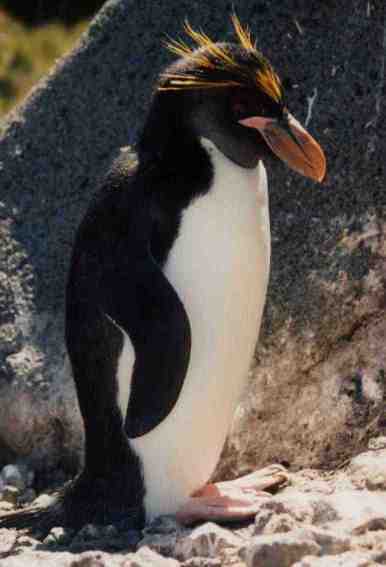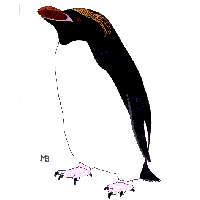


|
|
| |||



| ||||
 Macaroni Penguin Photo by Yan Ropert-Coudert by Mike Bingham Electronic download: $3.95 Paperback: $10.95 Proceeds fund our Research
Organisation for the Conservation of Penguins
Alvear 235
Casilla 263 |
|
.
Breeding Range: South Georgia, South Sandwich, South Orkneys, South Shetlands, Bouvet, Prince Edward, Marion, Crozet, Kerguelen, Heard, Falklands, Chile, Argentina and Antarctic Peninsula. The Macaroni penguin has an estimated world population of over 6 million breeding pairs. The main breeding sites are found on the islands of South Georgia, Crozet, Kerguelen, Heard, McDonald, Prince Edward and Bouvetoya, with other notable colonies in the South Shetlands, South Orkneys and islands off the coast of Southern Chile. The South American population stands at just 12,000 breeding pairs. The Falkland Islands has no actual Macaroni colonies, but does have about 50 breeding pairs breeding amongst Rockhopper penguins.
 MACARONI PENGUIN: Drawing by Mike Bingham Macaroni penguins are substantially larger than Rockhoppers, having an average length of around 70cm and an average weight of 5.5kg. They are the largest members of the genus Eudyptes. The head and upperparts are bluish black, and the underparts are white. The large reddish brown bill has exposed pink skin at its base; the eyes are red and the legs and feet are pink. The most distinctive features are the golden yellow crests which extend from the centre of the forehead and sweep backwards above the eyes. Females are smaller than the males, but have similar plumage. Juveniles lack the elegant crests, and have dull brown eyes, and browny black bills. Macaroni penguins breed in colonies on rocky coasts and low cliffs, with nesting densities ranging from 0.7 to 1.4 nests per sq.m. Two eggs are laid with a period of 4 to 5 days between the two. The first egg weighs about 93g and the second egg about 150g. The first egg is not only considerably smaller, but takes longer to incubate, and is rarely successful. Studies have shown that the first egg is often lost prior to the laying of the second egg, making it of little value as a backup. If both eggs are lost Macaronis do not re-lay. Incubation takes about 5 weeks, and incubation duties are divided into three roughly equal shifts. Both parents incubate the eggs during the first shift, after which the male goes to sea, and the female remains to do the second shift alone. When the male returns to do the third shift, the female goes to sea and does not return until the chicks have hatched. Regardless of the time spent at sea during incubation, Macaroni penguins always come ashore during daylight. On occasions the chick may have to wait for up to a week after hatching to receive its first feed. Meal sizes for the chicks average around 200g at this stage. The male continues to brood the chick for the first 24 days, while the female collects food for the chick. The chicks are fed on a daily basis, with females leaving the colony in early morning, and returning with food later the same day. The time spent foraging increases as the chicks get larger, and require more food to maintain growth. Macaroni penguins rarely forage more than 40km from the nest site during chick-rearing. By the end of the 24 days, the chicks have developed their mesoptile plumage, with dark grey upperparts and creamy white underparts. The mesoptile plumage, along with internal physiological changes, allows the chick to maintain its own body temperature away from the nest, and both parents are then able to forage at sea. This is important, since chick meal sizes can now be up to around 1000g per feed. When both parents are away at sea, the chicks gather into creches in order to gain protection from predators and cold weather. Chicks develop their waterproof plumage and fledge at about 11 weeks of age. They still lack the crests of the adults, and have instead a scattering of small yellow feathers. They also differ in having blackish brown bills and brown eyes. Once the chicks have left, the adults spend about three weeks at sea feeding in preparation for their annual moult. The moult lasts about 25 days, and adults then leave the breeding sites completely, and spend the winter months at sea. Females can begin breeding at 5 years of age, but the males do not normally breed until at least 6 years old. This may be a consequence of there being a greater number of males than females, allowing females to select more experienced males as partners. By contrast females can usually find a partner from amongst the surplus of males, as soon as they are physically able to breed. During their breeding life Macaroni penguins show high site and mate fidelity. Macaroni penguins feed on a variety of crustaceans, squid and fish. During chick-rearing, foraging for food is generally conducted on a daily basis, with adults returning to the nest site before dark. Macaroni penguins normally forage at depths of 15 to 70m, but have been recorded diving down to 100m on occasions. Some night foraging does occur, but dives are much shallower, ranging from only 3 to 6m depth. Dives rarely exceed 2 minutes in duration at any time. Natural predators, such as sealions and orcas (killer whales) occasionally take adults at sea, whilst gulls, skuas and birds of prey patrol breeding sites for eggs and young. Despite current populations being high at around 6 million breeding pairs, the world population has declined from about 9 million pairs in the late 1990s. Climate change and the reduction of food supply due to commercial fishing are the main reasons.
CLICK HERE to Adopt a Penguin of your very own.
|